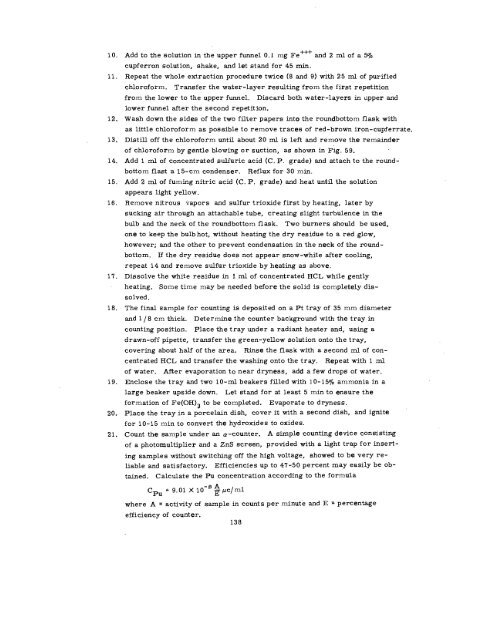THE RADIOCHEMISTRY OF PLUTONIUM - Sciencemadness.org
THE RADIOCHEMISTRY OF PLUTONIUM - Sciencemadness.org
THE RADIOCHEMISTRY OF PLUTONIUM - Sciencemadness.org
Create successful ePaper yourself
Turn your PDF publications into a flip-book with our unique Google optimized e-Paper software.
10.<br />
11.<br />
12.<br />
13.<br />
14.<br />
15.<br />
16.<br />
17.<br />
16.<br />
19.<br />
20.<br />
21.<br />
Add to the solution in the upper funnel 0.1 mg Fe+++ and 2 ml of a 5%<br />
cupferron solution, shake, and let stand for 45 min.<br />
Repeat the whole extraction procedure twice (8 and 9) with 25 ml of purified<br />
chloroform. Transfer the water-layer resulting from the first repetition<br />
from the lower to the upper funnel. Discard both water-layers in upper and<br />
lower funnel after the second repetition.<br />
Wash down the sides of the two filter papers into the roundbottom flask with<br />
as little chloroform as possible to remove traces of red-brown iron- cupferrate.<br />
Distill off the chloroform until about 20 ml is left and remove the remainder<br />
of chloroform by gentle blowing or suction, afi shown in Fig. 59.<br />
Add 1 ml of concentrated suJfuric acid (C. P. grade) and attach to the round-<br />
bottom flast a 15-cm condenser. Reflux for 30 min.<br />
Add 2 ml of fuming nitric acid (C. P. grade) and heat until the solution<br />
appe~s light yellow.<br />
Remove nitrous vapors and sulfur trioxide first by heating, later by<br />
sucking air through an attachable tube, creating slight turbulence in the<br />
bulb and the neck of the roundbottom flask. Two burners should be used,<br />
one to keep the bulb hot, without heating the dry residue to a red glow,<br />
however; and the other to prevent condensation in the neck of the round-<br />
bottom. If the dry residue does not appear snow-white after cooling,<br />
repeat 14 and remove sulfur trioxide by heating as above.<br />
Dissolve the white residue in 1 ml of concentrated HCL while gently<br />
heating. Some time may be needed before the solid is completely dis-<br />
solved.<br />
The final sample for counting is deposited on a Pt tray of 35 mm diameter<br />
and 1/8 cm thick. Determine the counter background with the tray in<br />
counting position. Place the tray under a radiant heater and, using a<br />
drawn-off pipette, transfer the green-yellow solution onto the tray,<br />
covering about half of the area. Rinse the flask with a second ml of con-<br />
centrated HCL and transfer the washing onto the tray. Repeat with 1 ml<br />
of water. After evaporation to near dryness, add a few drops of water.<br />
Enclose the tray and two 10-ml beakers filled with 10-15~0 ammonia in a<br />
large beaker upside down. Let stand for at least 5 min to ensure the<br />
formation of Fe(OH)3 to be completed, Evaporate to dryness.<br />
Place the tray in a porcelain dish, cover it with a second dish, and ignite<br />
for 10-15 min to convert the hydroxides to oxides.<br />
Count the sample under an a-counter. A simple counting device consisting<br />
of a photomultiplier and a ZnS screen, provided with a light trap for insert-<br />
ing samples without switching off the high voltage, showed to be very re-<br />
liable and satisfactory. Efficiencies up to 47-50 percent may easily be ob-<br />
tained. Calculate the Pu concentration according to the formula<br />
c Pu = 9.01 X 10-s ~pc/ml<br />
where A = activity of sample in counts per minute and E = percentage<br />
efficiency of counter.<br />
138
















